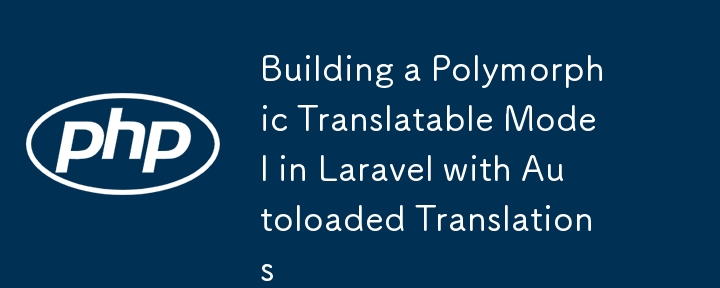自動ロードされた翻訳を使用して Laravel でポリモーフィックな翻訳可能モデルを構築する

多言語コンテンツを処理する場合、多くの場合、属性ごとに個別の行を保存するよりも、翻訳を JSON 列に保存する方が効率的です。このアプローチでは、翻訳が 1 つの列に統合され、データの管理と取得が簡素化されます。
翻訳システムのセットアップ
翻訳モデルとテーブルを拡張して、翻訳を保存するために JSON 列を使用できるようにします。これには、テーブル スキーマの更新と、JSON データを処理するための Translatable 特性の変更が含まれます。
ステップ 1: 移行テーブルの作成
変換テーブルがまだ存在しない場合は、新しい移行を作成します。
php artisan make:migration create_translations_table
ステップ 2: テーブル構造を定義する
database/migrations で生成された移行ファイルを開きます。新しいテーブルの場合は、次のように定義します:
use Illuminate\Database\Migrations\Migration;
use Illuminate\Database\Schema\Blueprint;
use Illuminate\Support\Facades\Schema;
class CreateTranslationsTable extends Migration
{
public function up()
{
Schema::create('translations', function (Blueprint $table) {
$table->id();
$table->string('locale'); // Stores the locale, e.g., 'en', 'fr'
$table->string('translatable_type'); // Stores the related model type, e.g., 'Post', 'Product'
$table->unsignedBigInteger('translatable_id'); // Stores the ID of the related model
$table->json('translations'); // Stores all translations as a JSON object
$table->timestamps();
});
}
public function down()
{
Schema::dropIfExists('translations');
}
}
ステップ 3: 移行の実行
データベースに移行を適用します:
php artisan migrate
ステップ 4: 翻訳モデルを作成する
次に、多態性関係を処理するための変換モデルを作成します。
php artisan make:model Translation
翻訳モデルで、ポリモーフィックな関係を定義します。
class Translation extends Model
{
protected $fillable = ['locale', 'translatable_type', 'translatable_id', 'translations'];
protected $casts = [
'translations' => 'array',
];
public function translatable()
{
return $this->morphTo();
}
}
JSON ストレージを使用した翻訳可能な特性の実装
複数のモデル間で翻訳処理を再利用できるようにするために、ユーザーが選択したロケールに基づいて翻訳されたコンテンツを自動的にロードする Translateable 特性を作成します。さらに、選択したロケールで利用可能な翻訳がない場合に、デフォルトのロケールからコンテンツをロードするフォールバック メカニズムを追加します。
ステップ 1: JSON 処理を使用して翻訳可能な特性を作成する
namespace App\Traits;
use App\Models\Translation;
use Illuminate\Support\Facades\App;
trait Translatable
{
public static function bootTranslatable()
{
static::retrieved(function ($model) {
$model->loadTranslations();
});
}
public function translations()
{
return $this->morphMany(Translation::class, 'translatable');
}
public function loadTranslations()
{
$locale = App::getLocale();
$defaultLocale = config('app.default_locale', 'en'); // Fallback to the default locale
// Try to load translations for the current locale
$translation = $this->translations()->where('locale', $locale)->first();
if (!$translation && $locale !== $defaultLocale) {
// If no translations are found for the current locale, fallback to the default locale
$translation = $this->translations()->where('locale', $defaultLocale)->first();
}
if ($translation) {
$translations = $translation->translations;
foreach ($translations as $key => $value) {
$this->{$key} = $value;
}
}
}
public function addTranslations(array $translations, $locale = null)
{
$locale = $locale ?? App::getLocale();
return $this->translations()->updateOrCreate(
['locale' => $locale],
['translations' => $translations]
);
}
}
ステップ 2: 翻訳可能な特性をモデルに適用する
翻訳サポートを必要とするモデルに、Translatable 特性を追加します。
namespace App\Models;
use App\Traits\Translatable;
use Illuminate\Database\Eloquent\Model;
class Post extends Model
{
use Translatable;
protected $fillable = ['title', 'content'];
}
例: 翻訳されたモデルの作成
翻訳を JSON オブジェクトとして追加します:
$post = Post::create(['title' => 'Default Title', 'content' => 'Default Content']);
// Adding translations
$post->addTranslations([
'title' => 'Hello World',
'content' => 'Welcome to our website'
], 'en');
$post->addTranslations([
'title' => 'Bonjour le monde',
'content' => 'Bienvenue sur notre site Web'
], 'fr');
翻訳されたモデルの取得
Post モデルを取得すると、現在のロケールに基づいて翻訳されたコンテンツが自動的に読み込まれるか、必要に応じてデフォルトのロケールに戻ります。
App::setLocale('fr');
$post = Post::find(1);
echo $post->title; // Displays "Bonjour le monde" if French translation exists
App::setLocale('es');
$post = Post::find(1);
echo $post->title; // Displays "Hello World" as it falls back to the English translation
翻訳されたコンテンツをビューに表示する
Blade ビューでは、他のモデル属性と同様に、翻訳されたコンテンツを表示できます。
<h1>{{ $post->title }}</h1>
<p>{{ $post->content }}</p>
結論
JSON 列を使用して翻訳を保存し、フォールバック メカニズムを実装することで、Laravel アプリケーションでの多言語コンテンツの管理を合理化します。このアプローチにより、翻訳が 1 つの列に統合され、データ処理が簡素化され、コードベースがより保守しやすくなります。ブログ、電子商取引サイト、またはその他の多言語アプリケーションを構築している場合でも、この方法によりスムーズで効率的なユーザー エクスペリエンスが保証されます。
お楽しみください!
以上が自動ロードされた翻訳を使用して Laravel でポリモーフィックな翻訳可能モデルを構築するの詳細内容です。詳細については、PHP 中国語 Web サイトの他の関連記事を参照してください。

ホットAIツール

Undresser.AI Undress
リアルなヌード写真を作成する AI 搭載アプリ

AI Clothes Remover
写真から衣服を削除するオンライン AI ツール。

Undress AI Tool
脱衣画像を無料で

Clothoff.io
AI衣類リムーバー

Video Face Swap
完全無料の AI 顔交換ツールを使用して、あらゆるビデオの顔を簡単に交換できます。

人気の記事

ホットツール

メモ帳++7.3.1
使いやすく無料のコードエディター

SublimeText3 中国語版
中国語版、とても使いやすい

ゼンドスタジオ 13.0.1
強力な PHP 統合開発環境

ドリームウィーバー CS6
ビジュアル Web 開発ツール

SublimeText3 Mac版
神レベルのコード編集ソフト(SublimeText3)

ホットトピック
 1672
1672
 14
14
 1428
1428
 52
52
 1332
1332
 25
25
 1277
1277
 29
29
 1257
1257
 24
24
 PHPでの安全なパスワードハッシュ(例:Password_hash、password_verify)を説明します。 MD5またはSHA1を使用してみませんか?
Apr 17, 2025 am 12:06 AM
PHPでの安全なパスワードハッシュ(例:Password_hash、password_verify)を説明します。 MD5またはSHA1を使用してみませんか?
Apr 17, 2025 am 12:06 AM
PHPでは、Password_hashとpassword_verify関数を使用して安全なパスワードハッシュを実装する必要があり、MD5またはSHA1を使用しないでください。 1)password_hashセキュリティを強化するために、塩値を含むハッシュを生成します。 2)password_verifyハッシュ値を比較して、パスワードを確認し、セキュリティを確保します。 3)MD5とSHA1は脆弱であり、塩の値が不足しており、最新のパスワードセキュリティには適していません。
 スカラータイプ、リターンタイプ、ユニオンタイプ、ヌル可能なタイプなど、PHPタイプのヒントはどのように機能しますか?
Apr 17, 2025 am 12:25 AM
スカラータイプ、リターンタイプ、ユニオンタイプ、ヌル可能なタイプなど、PHPタイプのヒントはどのように機能しますか?
Apr 17, 2025 am 12:25 AM
PHPタイプは、コードの品質と読みやすさを向上させるためのプロンプトがあります。 1)スカラータイプのヒント:php7.0であるため、基本データ型は、int、floatなどの関数パラメーターで指定できます。 3)ユニオンタイプのプロンプト:PHP8.0であるため、関数パラメーターまたは戻り値で複数のタイプを指定することができます。 4)Nullable Typeプロンプト:null値を含めることができ、null値を返す可能性のある機能を処理できます。
 PHPおよびPython:さまざまなパラダイムが説明されています
Apr 18, 2025 am 12:26 AM
PHPおよびPython:さまざまなパラダイムが説明されています
Apr 18, 2025 am 12:26 AM
PHPは主に手順プログラミングですが、オブジェクト指向プログラミング(OOP)もサポートしています。 Pythonは、OOP、機能、手続き上のプログラミングなど、さまざまなパラダイムをサポートしています。 PHPはWeb開発に適しており、Pythonはデータ分析や機械学習などのさまざまなアプリケーションに適しています。
 PHPおよびPython:コードの例と比較
Apr 15, 2025 am 12:07 AM
PHPおよびPython:コードの例と比較
Apr 15, 2025 am 12:07 AM
PHPとPythonには独自の利点と短所があり、選択はプロジェクトのニーズと個人的な好みに依存します。 1.PHPは、大規模なWebアプリケーションの迅速な開発とメンテナンスに適しています。 2。Pythonは、データサイエンスと機械学習の分野を支配しています。
 PHPでのSQL注入をどのように防止しますか? (準備された声明、PDO)
Apr 15, 2025 am 12:15 AM
PHPでのSQL注入をどのように防止しますか? (準備された声明、PDO)
Apr 15, 2025 am 12:15 AM
PHPで前処理ステートメントとPDOを使用すると、SQL注入攻撃を効果的に防ぐことができます。 1)PDOを使用してデータベースに接続し、エラーモードを設定します。 2)準備方法を使用して前処理ステートメントを作成し、プレースホルダーを使用してデータを渡し、メソッドを実行します。 3)結果のクエリを処理し、コードのセキュリティとパフォーマンスを確保します。
 PHP:データベースとサーバー側のロジックの処理
Apr 15, 2025 am 12:15 AM
PHP:データベースとサーバー側のロジックの処理
Apr 15, 2025 am 12:15 AM
PHPはMySQLIおよびPDO拡張機能を使用して、データベース操作とサーバー側のロジック処理で対話し、セッション管理などの関数を介してサーバー側のロジックを処理します。 1)MySQLIまたはPDOを使用してデータベースに接続し、SQLクエリを実行します。 2)セッション管理およびその他の機能を通じて、HTTPリクエストとユーザーステータスを処理します。 3)トランザクションを使用して、データベース操作の原子性を確保します。 4)SQLインジェクションを防ぎ、例外処理とデバッグの閉鎖接続を使用します。 5)インデックスとキャッシュを通じてパフォーマンスを最適化し、読みやすいコードを書き、エラー処理を実行します。
 PHPの目的:動的なWebサイトの構築
Apr 15, 2025 am 12:18 AM
PHPの目的:動的なWebサイトの構築
Apr 15, 2025 am 12:18 AM
PHPは動的なWebサイトを構築するために使用され、そのコア関数には次のものが含まれます。1。データベースに接続することにより、動的コンテンツを生成し、リアルタイムでWebページを生成します。 2。ユーザーのインタラクションを処理し、提出をフォームし、入力を確認し、操作に応答します。 3.セッションとユーザー認証を管理して、パーソナライズされたエクスペリエンスを提供します。 4.パフォーマンスを最適化し、ベストプラクティスに従って、ウェブサイトの効率とセキュリティを改善します。
 PHPとPythonの選択:ガイド
Apr 18, 2025 am 12:24 AM
PHPとPythonの選択:ガイド
Apr 18, 2025 am 12:24 AM
PHPはWeb開発と迅速なプロトタイピングに適しており、Pythonはデータサイエンスと機械学習に適しています。 1.PHPは、単純な構文と迅速な開発に適した動的なWeb開発に使用されます。 2。Pythonには簡潔な構文があり、複数のフィールドに適しており、強力なライブラリエコシステムがあります。




